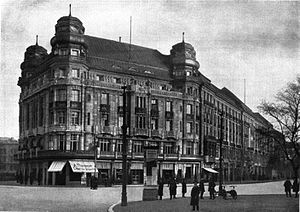Hotel Furstenhof (Berlin)

The Hotel Fürstenhof was a traditional luxury hotel on Potsdamer Platz in Berlin-Mitte . It already existed as a middle category hotel in the second half of the 19th century and reopened as a luxury hotel in 1907. The hotel was destroyed in the Second World War .
A hotel in a convenient location
According to information from travel guides of the 19th century, the Hotel Fürstenhof already existed in the second half of the 19th century as a middle-class hotel on Leipziger Platz (No. 2). The operation of the hotel benefited from its convenient location on the busy Potsdamer Platz with the Potsdamer Bahnhof . Nearby on the north side of Potsdamer Platz were the Grand Hotel Bellevue and the Palast Hotel . Not far away was the Anhalter Bahnhof on Askanischer Platz .
This older and rather simple building of the Hotel Der Fürstenhof offered space for 50 rooms. The last owner of the old Fürstenhof hotel in this form - with the address Leipziger Platz 2 - was the hotelier Heinrich Quitz (there is evidence of 1899–1905). In 1905 he sold the hotel building to the catering company Aschinger and then tried to install a new hotel under the name Fürsten-Hotel at Markgrafenstraße 49 directly on Gendarmenmarkt . The Fürsten-Hotel on Gendarmenmarkt only existed from 1906 to 1909.
Expansion into a luxury hotel
The catering company Aschinger launched an architectural competition for the large plot of land in an exposed location on Potsdamer and Leipziger Platz as well as on Königgrätzer Straße (since 1947 Stresemannstraße ), the result of which is documented in Berlin's architecture world from July 1905. The victorious Berlin architects Richard Bielenberg and Josef Moser built the new Hotel Fürstenhof from 1906–1907 .
By purchasing adjacent properties, the hotel area was able to be extended into Königgrätzer Strasse in particular. In its new, considerably enlarged form, the hotel had 300 rooms. The architecture of the new building showed elements of Art Nouveau , the beginning modern and neo-baroque . The interior of the building was also lavishly decorated. a. through a fountain by Ludwig Vordermayer and carvings by Richard Kühn . The Greaves travel guide listed the Fürstenhof in its list of hotels "first and foremost" in 1920 and judged it: "Elegant house with every comfort" and refers to the Fürstenhof café attached to the hotel.
War damage and demolition
In November 1943, the building was damaged by aerial bombs during a British air raid on Berlin and the ruins were completely demolished in the 1950s.
literature
- Max Creutz : The Fürstenhof. In: Berliner Architekturwelt , 10th year 1907/1908, issue 10 (January 1908) , pp. 361–400.
- Architects and Engineers Association of Berlin (ed.): Hospitality. (= Berlin and its buildings , part 8 (buildings for trade and commerce), volume B.) Ernst & Sohn, Berlin et al. 1980, ISBN 3-433-00825-6 , pp. 6-9 and p. 40.
Individual evidence
- ↑ cf. Karl Baedeker : Berlin and surroundings. Guide for travelers. 5th edition Leipzig 1887. p. 14.
- ↑ cf. Karl Baedeker: Berlin and the surrounding area. Guide for travelers. 13. Aufl. Leipzig 1904. S. 5. A photo of the older building of the hotel "Fürstenhof" by the Berlin photographer Max Missmann can be found in the magazine "Berliner Leben", issue 08 (1905).
- ↑ According to the Berlin address books, "Scheible's Hotel" had existed at the same location from 1851–1883.
- ↑ Hotel Aschinger competition . In: Berliner Architekturwelt , 8th year 1905/1906, issue 4, July 1905, p. 126ff.
- ↑ www.luise-berlin.de
- ↑ cf. Karl Baedeker: Berlin and the surrounding area. Guide for travelers. 18th edition Leipzig 1914. p. 4.
- ↑ cf. Anonymous: Berlin. Small edition. Extract from the 60th edition of the large edition. Griebens travel guide Volume 25. Albert Goldschmidt Verlag, Berlin 1920/21, p. 7.
- ↑ www.potsdamer-platz.org
Coordinates: 52 ° 30 ′ 31.3 " N , 13 ° 22 ′ 37.9" E


